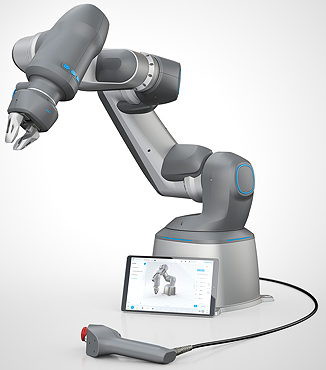- Home » News » Technology News
First pneumatic cobot will cost less than electric rivals

Festo has previewed what it claims will be the world’s first pneumatic cobot. It says that the device – due to go on sale in 2023 – will be cheaper than electric cobots in the same class, as well as offering other attractions such as a high sensitivity to collisions and a low weight.
Unlike electric drives, the six pneumatic direct drives in the cobot’s articulated joints do not need heavy gearboxes or expensive force-torque sensors, thus cutting costs and weight. The pneumatic drives allow the arm to be guided by hand without any resistance so that waypoints or paths can be taught quickly and precisely.
The cobot can handle payloads up to 3kg, has a reach of 670mm and weighs 17kg – allowing it to be moved easily from one location to another. It consists of the arm, a handheld module and software (called Robotic Suite) for intuitive commissioning and programming. It is said to be possible to have the cobot up and running in less than an hour, without needing robotics expertise. The software offers three programming techniques: icon-based function blocks that can be used by novices; hand-guided operation; and text-based programming for experts.
A compact controller is built into the robot’s base, making it particularly flexible, saving space and allowing it to be moved easily from one location to another. Simple connections avoid long changeover times. Common bus standards – including Profinet, EtherCat and Ethernet/IP – enable fast links to higher controllers.
The flexible pneumatic drives allow the cobot to act at a speed appropriate to the situation and to move smoothly. It is said to be as soft to the touch as human contact.
The direct-drive mechanism in each joint consists of a pair of air chambers separated by a divider. To move the joint, one chamber or the other is pressurised. If the arm makes contact with someone or something as it is moving, this is detected by sensors and the information is sent to the central controller which, in turn, sends signals to the other joints to trigger braking functions. The pressure in the chambers is equalised using short-circuit valves. Torque is reduced to zero and the arm stops moving.
The pneumatic direct drives decouple the masses of the structure and the cobot, resulting in a much lower effective mass than an electrically powered cobot, according to Festo. The lightweight structure means that less energy is transmitted in the event of an impact.

“Thanks to precise pressure regulators in the articulated joints, the robot recognises when it is being touched and responds with appropriate safety functions,” explains Festo’s head of robotics, Christian Tarragona. Personnel can work with the robot “in complete safety,” he adds.
Festo board member Dr Frank Melzer expects the low cost, ease of programming and flexibility of the pneumatic cobot to appeal, in particular, to smaller manufacturers. He gives examples of four target applications:
• labelling and tagging, especially where soft materials are involved;
• autonomous machine tending;
• loading and unloading, especially for applications such as PCB testing; and
• depowdering operations requiring complex movements in applications such as 3D printing and painting.
Melzer predicts that the pneumatic cobot “will set new standards in human-robot collaboration with its ease of use,” when it goes on sale next year. He says that it will be priced “just below” comparable electrically powered cobots.
The pneumatic cobot will make its public debut at the Hannover Messe trade show later this month.
Festo: Twitter LinkedIn Facebook





